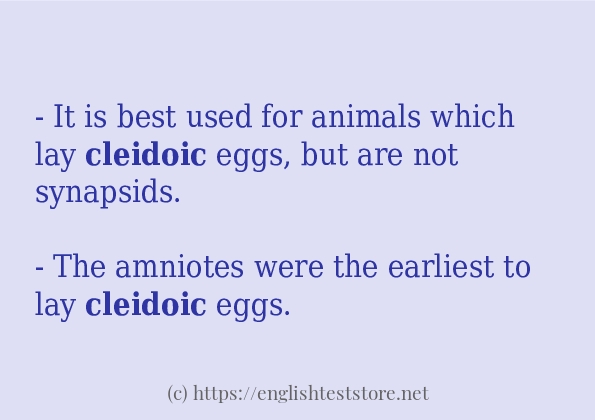How to use in-sentence of “cleidoic”:
– It is best used for animals which lay cleidoic eggs, but are not synapsids.
– The amniotes were the earliest to lay cleidoic eggs.
– The cleidoic egg is the type of egg which reptiles and birds lay.
– It is a main character of the cleidoic egg, which allows amniotes to breed on land.
– Reptiles, birds and monotremes lay cleidoic eggs: bird eggs are an example.
– The cleidoic egg must have been developed in the latest Devonian or early Carboniferous.
– Whereas amphibia lay their eggs in water, all other tetrapods lay cleidoic eggs.
– They were the amniotes, whose key innovation was the cleidoic egg.

Example sentences of “cleidoic”:
- The cleidoic egg is a good example of an evolutionary innovation which permitted the invasion of a vast range of new habitats, and led to one of the greatest adaptive radiations in the history of the vertebrates.
- They laid cleidoic eggs, which had hard shells, and could be laid out of water.
- Almost all parrots nest in tree hollows, and lay white Cleidoic eggeggs from which hatch altricial young.
– The cleidoic egg is a good example of an evolutionary innovation which permitted the invasion of a vast range of new habitats, and led to one of the greatest adaptive radiations in the history of the vertebrates.
– They laid cleidoic eggs, which had hard shells, and could be laid out of water.
– Almost all parrots nest in tree hollows, and lay white Cleidoic eggeggs from which hatch altricial young.
– The ‘invention’ of the cleidoic egg, and its embryonic membranes, is the main reason why the eggs of an amniote do not need to be laid in water.
– Thus, from the initial step of a cleidoic egg comes a number of changes in behaviour.
– The significance of the cleidoic egg is that it enables reproduction out of, and often away from, water.
– There are only five species that lay Cleidoic eggeggs, the duck-billed platypus “Ornithorhynchus”, and four species of spiny anteater “Echidna”.
– A most striking example is the cleidoic egg, Eggs like those of modern reptiles and birds.
– The cleidoic egg is sometimes called the amniotic egg, because it is characteristic of amniotes.
– They are nevertheless much smaller than the cleidoic eggs laid externally by reptiles and birds, which is why they need a long period of internal development in the womb.
– They are the land vertebrates which lay cleidoic eggs.
– These later adaptations were made possible by the earlier evolution of the cleidoic egg.
– These are also cleidoic eggs, but all the development is done inside the mother’s body, as with humans.
– The early tetrapods split first into two major groups: the amphibians, which laid their egg eggs in water, and the amniotes, who laid their cleidoic eggs on land.
– Some give birth to live young, with the cleidoic eggs developing internally.
– Mammalian reproduction has evolved from laying cleidoic eggs to live birth.
– Most penguins lay two Cleidoic eggeggs per year but emperor penguins lay only one.
– Amniotes developed the cleidoic egg early in the Carboniferous period, and this meant they could live and reproduce on dry land.
– Marge lays an cleidoic eggegg, but they are found by Chief Wiggum, a Pilgrim.
